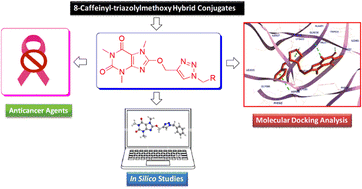Design, synthesis, anticancer and in silico assessment of 8-caffeinyl-triazolylmethoxy hybrid conjugates†
Abstract
In this research the synthesis, characterization, anticancer and the cytotoxicity assessments of novel 8-caffeinyl-triazolylmethoxy hybrid conjugates have been described. These compounds are the first caffeine-1,2,3-triazolyl hybrid molecules that structurally are composed of three compartments comprising caffeinyl, 1,2,3-triazolyl and N-alkyl/aryl residues. The in vitro evaluations of synthesized compounds on cancer cell lines, including two breast cancer cell lines MDA-MB-468 (ATCC HTB-22), MCF-7 (ATCC HTB-22), melanoma cell line A-375 (ATCC CRL-1619) and normal cell line HEK-293 (ATCC CRL-11268) have determined that 22c (IC50 < 12.5 μM) demonstrated potent activity against A375 and its toxicity is even stronger than methotrexate (MTX) as a standard drug. Additionally, 22c involves more selectivity than MTX regarding its non-toxicity for the HEK-293 cell line. Among the tested compounds against two breast cancer cell lines, 22f (IC50 = 136 ± 0.2 and 126 ± 0.6 μM for MCF-7 and MDA-MB-468, respectively) and 22i (IC50 = 165 ± 1.8 and 175 ± 1.4 μM for MCF-7 and MDA-MB-468, respectively) were the most potent compounds but their activities were less than MTX, moreover 22f showed more selectivity regarding its lower toxicity against HEK-293. Overall, 22f displayed general toxicity and selectivity on all tested cancer cell lines. The in silico physicochemical properties, pharmacokinetic profile, and drug likeness predictions were also carried out for all the studied compounds. Most new compounds exhibited zero violation of Lipinski's rule (RO5). A molecular docking study was also conducted to predict the binding mode and the interaction of 22c as the most active anti-melanoma entry with B-RAF V600E kinase enzyme. The docking results determined that 22c exhibited a strong binding affinity to the active site of the enzyme. These findings demonstrated 22c and 22f as potential future anticancer drug candidates.



 Please wait while we load your content...
Please wait while we load your content...